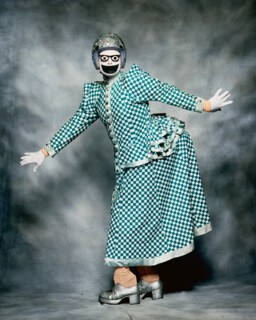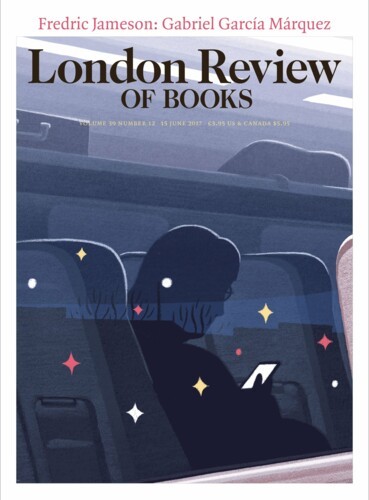On 28 September 1992, the artist and London nightclub impresario Leigh Bowery took the stage at Kinky Gerlinky, a peripatetic club then established in Leicester Square. Wearing sunglasses, a headscarf and a striped cotton dress, the imposing Bowery had got himself up as Divine – his most obvious precursor – in John Waters’s film Female Trouble (1974). Looking conspicuously larger than usual, Bowery fell to the floor moaning and through his tights ‘birthed’ his naked friend (and future wife) Nicola Bateman. The umbilical cord was a string of sausages. The pair repeated the birth routine several times over the next two years, before Bowery’s death from Aids-related meningitis on New Year’s Eve 1994. In video footage at Tate Modern, where Leigh Bowery! runs until 31 August, the performance erupts between ‘Useless Man’, a dirge from Bowery’s trash art noise band Minty, and a rendition of David Bowie’s ‘Ashes to Ashes’. What might Bowery have identified with in the latter song? I ain’t got no money and I ain’t got no hair? Or something to do with salacious self-mythology? Sordid details following …
He was born in 1961 and grew up in Sunshine, a suburb of Melbourne, before moving to London in 1980. An exhibition label briefly notes a parallel with Barry Humphries, who made the same journey following a prankish Dadaist youth in Melbourne. Nick Cave also relocated to London around the same time as Bowery. Was some antic influence at work down there, or just the urge to escape and scandalise? Bowery had missed the convulsions of Punk – ‘I’m the Punk of the 1980s!’ he declared later, by which he meant he was a whole movement – and found himself socially and creatively excluded from the brittle New Romantic scene that succeeded it. In a diary entry from this period, alongside a resolution to control his weight, Bowery writes that he must soon make his mark in art, fashion or literature. The last is funny: the crowd at Taboo, the club where he reigned mid-decade, may have been camp and cutting and culturally savvy, but they weren’t noted for verbal wit, save for the doorman, Marc Vautier, who would direct unlucky punters to a mirror: ‘Would you let yourself in?’
‘I have always thought about/staying in and going out,’ New Order sang in 1985, the year Taboo opened. Bowery and his friend and sometime lover Trojan styled themselves as garish emissaries of the new scene, jewelled and body-painted, sporting a look they lamentably named ‘Pakis from Outer Space’. (Bowery’s immersion in London’s club and street culture did not improve his racial politics: a pre-Minty band appeared in blackface.) Wearing platform boots, they led one of the first 1970s revivals in the 1980s: pop veterans such as ABC and Boy George soon borrowed from their palette and repertoire. Taboo, however, was about more than style: the club was part of Bowery’s larger ambition to provoke. To Dada, Warhol’s Factory and the films of Waters, we might add to the list of Bowery’s influences the Viennese Actionists and the performance artist Chris Burden, who had himself shot in the arm and later nailed to a Volkswagen Beetle. Bowery once planned to walk up to the bar at Taboo with an axe and chop off his own hand, but he chickened out.
I remember reading about this in one of the London style magazines of the time; it all seemed exotically removed from New Romantic sangfroid and the zoot-suited excess of good taste that had supplanted it. For a while, Bowery touted himself as a legitimate if outré fashion designer, but it’s clear from the Tate show that it was never going to work: he was too addicted to the one-off extravagance of ‘the look’ to commit himself to the practical demands of a collection or commercial line. His diverse looks are the main attraction in this exhibition, whether photographed, hung on the walls or draped on Bowery-scale dummies. Here he is in a low-cut glittery green bodice, scarlet gloves, a silver cape and the sort of skull-hugging mask last seen on 1970s wrestlers. And again in all-over polka-dot fur, in black-and-white clown face, head like a cracked Alien egg with waxy black rivulets running from the crown. The one exquisitely wearable thing he made was for a Blitz magazine feature in 1986: a Levi’s denim jacket covered with a haze of golden hairpins.
In the same year, Bowery reached the teatime TV mainstream when he appeared on the BBC’s Clothes Show to model and comment on a selection of his looks. A monster with multiple pairs of goggle-eyed sunglasses, a crash helmet or meringue-like confection passing for a wig, he had more in common with Hugo Ball at the Cabaret Voltaire in 1916 than he did with anything in the Hamnett-Westwood-Ozbek axis of London fashion in the mid-1980s. Bowery is even wilder-looking and more endearing on the same programme two years later, visiting Harrods while resembling a frilled gingham sea slug, and assuring viewers in velvet tones that he’s been coming to the store since he was a small boy: ‘The staff adore me here.’ Nightclubs and magazine shoots may have been his natural environment, but he came differently alive when out of context. In October 1988, he appeared for a week as an art object of sorts at Anthony d’Offay Gallery in London. Dick Jewell’s film What’s Your Reaction to the Show? records visitors’ reactions: boredom, puzzlement, awe. It’s impossible now not to recall that the performance took place in the same year Section 28 was passed.
In the mid-1980s Bowery began working with the dancer and choreographer Michael Clark, at first as a costume designer and later as a performer in his own right. In 1984, the bare arses of Bowery’s costumes made it onto another BBC show, Whistle Test, in a performance with the Fall: the band’s music was already part of Clark’s choreography, but they now embarked on a collaboration proper. The artist Charles Atlas provides the best documentary evidence of Bowery’s relationship with Clark. Atlas’s film Hail the New Puritan (1986) includes performance footage and semi-fictional interludes at home with Bowery and friends – including Trojan, who died of a heroin overdose the same year. When Bowery eventually joined Clark and his dancers on stage, he added a further element of affront to the company’s body of work, as if to say: How dare I? The pair eventually fell out over one of Bowery’s more cartoonish costumes: a foam and lycra bodysuit that covered the wearer from head to toe and had ‘A CUNT’ emblazoned across the face in black type.
His work with Clark was in some ways the summit of his creative potential – what to do with your outraging presence when fashions change and you have failed to parlay your persona into a long-term lucrative career? Bowery was ill-suited to the dressed-down rave scene of the late 1980s, but he was always at some club, looking increasingly abstract, as though he’d become his own logo. At other times, he seemed a more flagrantly physical being, with his flesh squeezed to resemble cleavage and a spiky merkin to hide his tucked genitals. Lucian Freud’s nude paintings of him captured an unaccustomed vulnerability, but Bowery pursued more aggressive styles in public. In a murky video at Tate Modern, a mistimed onstage enema sprays an early-1990s audience. The singer and drag artist Alan Pillay once called Bowery ‘the sickest person that a spotlight ever hit’. Had he lived, it is hard to imagine him on a chat-show sofa or in a podcast studio, mildly revisiting his days of excess.
Send Letters To:
The Editor
London Review of Books,
28 Little Russell Street
London, WC1A 2HN
letters@lrb.co.uk
Please include name, address, and a telephone number.


